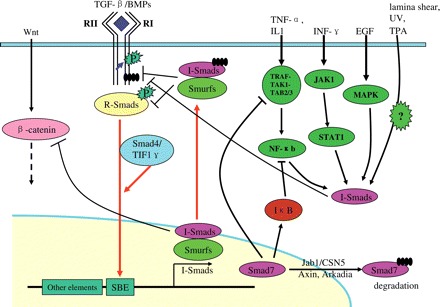Fig. 2.

I-Smads mediate the crosstalk of the TGF-β signaling pathway with other pathways I-Smads could be transcriptionally induced by TGF-β/BMPs signaling and inhibit their signaling by negative feedback loops. Besides, they could also be induced by many other cytokines or stimuli, such as TNF-α/IL1, INF-γ, EGF, laminar shear stress, UV, TPA, etc. Smad7 has been reported to enhance the transcription of IκB, which is a key inhibitor of NF-κB signaling pathway. It may also disrupt the TRAF–TAK1–TAB2/3 complex, thus inhibiting NF-κB signaling. In addition, Smad7 was reported to down-regulate the protein level of β-catenin by recruitment of E3 ligase Smurf1. Smad7 itself could be degraded both in the nucleus and in the cytoplasm in proteasomal pathway.
